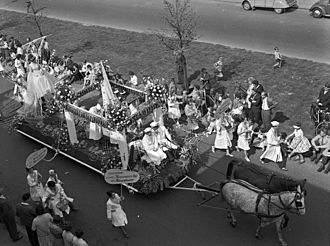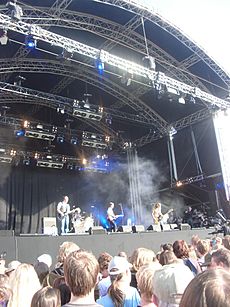Liberation Day (Netherlands) facts for kids
Quick facts for kids Liberation Day |
|
|---|---|

Liberation Day parade in 1960 in Utrecht
|
|
| Official name | Bevrijdingsdag |
| Observed by | Netherlands |
| Type | National Day |
| Celebrations | Music festivals |
| Date | 5 May |
| Frequency | annual |
| Related to | Liberation of the Netherlands from German occupation during World War II |

Liberation Day (Dutch: Bevrijdingsdag) is a public holiday in the Netherlands to mark the end of the German occupation of the country during the Second World War. It follows the Remembrance of the Dead (Dodenherdenking) on 4 May.
The Netherlands were liberated by Canadian forces, British infantry divisions, the British I Corps, the 1st Polish Armoured Division, American, Belgian, Dutch and Czechoslovak troops. Parts of the country, in particular the south-east, were liberated by the British Second Army which included American and Polish airborne forces (see Operation Market Garden) and French airbornes (see Operation Amherst). On 5 May 1945, at Hotel de Wereld in Wageningen, I Canadian Corps commander Lieutenant-General Charles Foulkes and Oberbefehlshaber Niederlande commander-in-chief Generaloberst Johannes Blaskowitz reached an agreement on the capitulation of all German forces in the Netherlands. The capitulation document was signed the next day in the auditorium of Wageningen University, located next door.
After liberation in 1945, Liberation Day was celebrated every five years. In 1990 the day was declared a national holiday when liberation would be remembered and celebrated every year. Festivals are held in most places in the Netherlands with parades of veterans and musical festivals throughout the whole country.
See also
- Battle of the Netherlands
- Liberation of the Netherlands
- Liberation Day
- Liberation of Arnhem
- Victory in Europe Day
- Marine memorial

